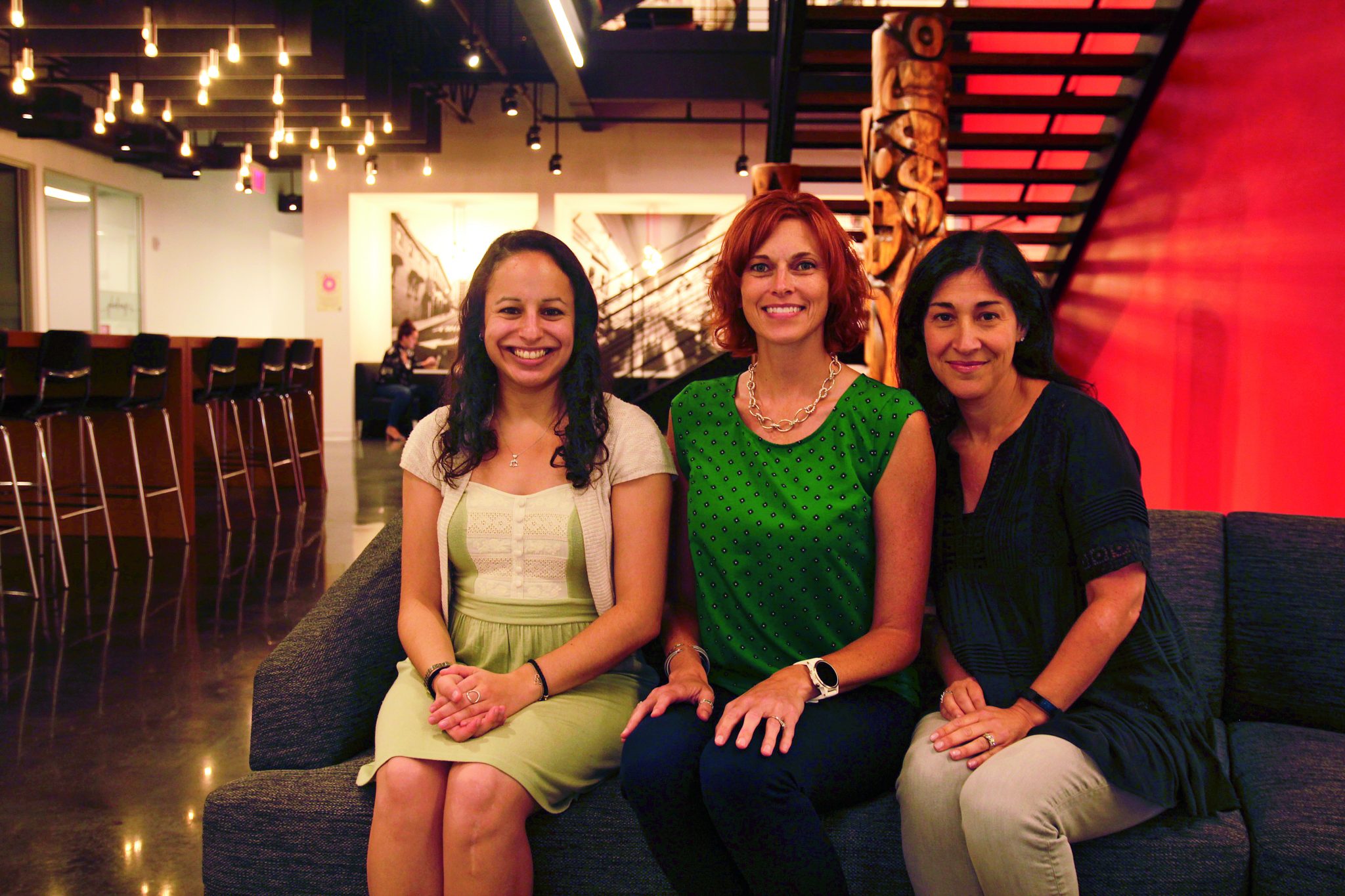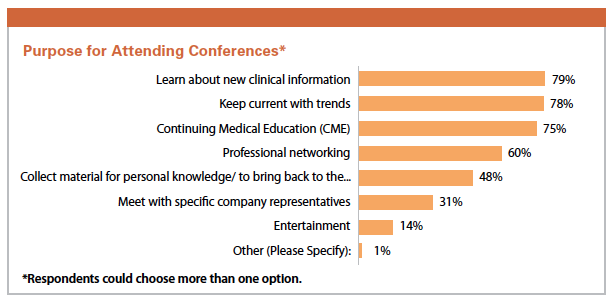
Brand planning season is upon us, and in planning for 2018 tactics, the subject of having a presence at medical conferences inevitably comes up. What motivates healthcare professionals to attend conferences? What activities do they participate in once they get there? What types of engagements are most impactful? How do we break through the noise of all other brands and booths to ensure that HCPs retain our content and messaging? Earlier this year, we at OCHWW had similar thoughts and decided it was time to find out some answers.
Following two large U.S.-based medical conventions, we conducted online surveys of attendees to garner insights on what is most relevant to HCPs when they attend conferences and to understand how individual brands play a role within their conference experiences. We surveyed 75 gastroenterologists after Digestive Disease Week (DDW) in May and 75 oncologists after the American Society of Clinical Oncology (ASCO) in June. All respondents were U.S.-based physicians who have been practicing for two to 35 years. The gastroenterologists averaged 13.8 years in practice while the oncologists averaged 15.6 years in practice.
The survey yielded a number of results that can help you make decisions as you plan for your next medical conference. Read on for a recap of the results and five key takeaways for ensuring that your next conference is as impactful as possible.
By the Numbers
Although the general consensus is that conference attendance is declining, on average, the physicians we surveyed attend three conferences per year. The vast majority of respondents attend conferences to learn about new clinical information (79%) and keep current with trends (78%). Continuing medical education (CME) followed closely, with fully three-quarters of respondents attending conferences for that purpose.
Once at a conference, nine out of 10 HCPs attend keynote presentations, and 82% attend symposia. Booth visits and poster  presentations, with 77% and 73% of respondents, respectively, round out the top four activities at conferences. Meeting with specific company representatives, product theaters, and social cocktail hours seem to be less of a draw for survey respondents.
presentations, with 77% and 73% of respondents, respectively, round out the top four activities at conferences. Meeting with specific company representatives, product theaters, and social cocktail hours seem to be less of a draw for survey respondents.
Since brands spend most of their conference marketing dollars on what happens inside the booth, we delved deeper into what was most impactful in the booth and how likely attendees were to interact with different types of content within each booth.
The Booth Experience
As noted above, 77% of respondents interact with booths at conferences. Company representatives and booth staff are the most important elements of the booth (4.7 on a 5-point scale). Respondents cited engaging content and high-quality booth reps as being essential, stating “good product info, knowledgeable and friendly staff," “vivid displays and kind staff," and “great reps" as reasons booths were impactful for them.
Printed clinical materials (4.3/5) are the second-most important element in the booth, with 81.5% of respondents reporting that their main source of retaining information from a booth is by acquiring clinical brochures and handouts. The quality of information presented within the booth had the greatest impact on respondents when it came to their booth experience. “Good product info," “best clinical information presentation," and “most groundbreaking information" were cited by respondents as the reasons the most impactful booths had such great effect on them.
Aside from brochures and handouts, 52.5% of respondents reported signing up to receive more information through email at a conference booth. 20% take giveaways (aka schwag) and 17.5% of respondents take pictures of content in the booth to retain information.
Virtual reality experiences and touchscreens rank as average importance in a booth (3.4/5 and 3.0/5, respectively). Games ranked as low importance, coming in at 1.5/5. That said, technology can be a big driver of booth traffic, drawing conference attendees into the booth to interact with reps and clinical information. Such technology as proximity sensors, which can modify the messaging the closer an attendee gets to your booth, can pique the interest of attendees and engage them with your content before they even reach your booth.
Turning Knowledge Into Action
Engaging booths and helpful reps are all well and good, but do conference experiences actually impact treatment decisions? On average, respondents’ conference experiences were more likely than not to have an effect on their future treatment decisions, ranking a 3.73/5. One respondent even indicated that his/her convention experience “will change how I manage patients." Knowing this, it is imperative for brands to drive positive convention experiences in 2018 and beyond. Below are five key actionable insights for ensuring high-quality traffic in your booth at your next medical conference.
1. Make some noise
Interestingly, almost 20% of respondents visit booths only if they have prior interest in a product. Since many companies use conferences to launch new products and release new clinical data, it is vital for companies to use social and digital media to drive awareness of their brands and data ahead of the conference. Emails to conference attendees and robust social media campaigns leveraging the conference hashtag are good ways to get the word out about your brand ahead of the conference. Social media can also be leveraged during the conference and post-conference as well to keep the buzz about your brand going.
2. Give HCPs what they want
Since clinical information is the most important thing that HCPs take away from conferences, you need to deliver it to them in an impactful way. Knowledgeable booth staff and engaging booth experiences will help HCPs retain information beyond the conference. Allowing attendees to scan their badges to receive further clinical information through email post-conference will allow you to continue your brand conversation beyond the booth. Post conference emails can also be helpful to reinforce messaging or for attendees who may have missed the conference booth.
3. Use technology purposefully
As noted above, technology in a booth can be a big draw, but technology without a strong narrative or messaging can detract from your brand’s booth experience. Ensure that your choice of technology is appropriate for the presentation of your clinical data and that it enriches your brand’s story, and HCPs will retain not only the information but the positive brand experience as well. Interactive quizzes and immersive experiences can help tell your brand story and MOA in ways that HCPs will find memorable and impactful. Large prescribing information screens can also help facilitate key conversations between HCPs and reps that guide the interaction and make it more meaningful.
4. Continue the conversation
Since about half of attendees sign up for more information through email and over 80% take brochures and printed materials with them from the booth, post-conference communications need to be seamless with the booth experience and extend the relationship that was formed with the reps in the booth. Remind attendees about their experience within the booth, reinforce the information they learned, and then continue the brand conversation through a meaningful CRM stream and also through rep visits as appropriate.
5. Remember to measure
As you exhibit at conferences throughout the year, measurement planning is necessary to ensure that you learn as much as possible from your booth experiences. At a minimum, you should track scanned badge visits to your booth to understand who the visitors are, including their occupations, affiliations, and locations. This information can help you understand your target audience. For interactive booth experiences, time spent per visit, number of visitors per hour, number of pages viewed, number of items clicked, the amount of content explored, etc., can all help you understand attendees’ key engagements with your brand. Using measurement to optimize future campaign experiences is necessary to ensure that you are engaging visitors as effectively as possible.
Looking to the Future
In 2018, conferences will be bigger and brighter, and it will be even more difficult to differentiate your brand from all of the others that are vying for HCPs’ attention. By using the insights gleaned above, we can help ensure your brand’s success in 2018 and beyond. (PV)
Ogilvy CommonHealth Worldwide — the health behavior specialists of Ogilvy & Mather and a WPP Health & Wellness company — is committed to creativity and effectiveness in healthcare communications, everywhere.
For more information, visit ochww.com.

















